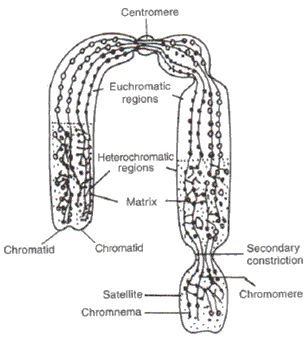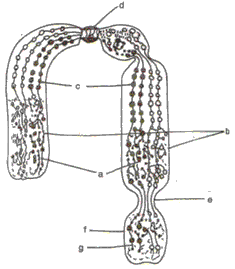Chapter 2 - Structure of Chromosomes Exercise 20
Question 1
What is chromatin?
Solution 1
Chromatin is an extremely thin, long nuclear fibre occurring in the nucleus before cell division.
Question 2
What do you understand by sex chromosomes?
Solution 2
The chromosomes which determine the sex of an individual are called sex chromosomes.
Question 3
How are sex chromosomes significant?
Solution 3
Sex chromosomes are significant as they determine the sex of an individual.
Question 4
What are the sex chromosomes in man?
Solution 4
In man, there is a pair of sex chromosomes. In males, it is X and Y while in female, the sex chromosomes are X and X which are identical to each other.
Question 5
Give the importance of chromosomes as hereditary material.
Solution 5
Chromosomes are the main source of chemical information which determines that the cell should become like its parent cell.
During the developmental stage they also determine that the cells of the organism will give the animal or the plant, the characteristic features of its species.
During the developmental stage they also determine that the cells of the organism will give the animal or the plant, the characteristic features of its species.
Question 6
Name the two nucleic acids. Who discovered them?
Solution 6
DNA and RNA are the two nucleic acids.
Frederick Miescher discovered DNA.
Frederick Miescher discovered DNA.
Question 7
What are nucleic acids made of?
Solution 7
Nucleic acids are made up of three types of molecules:
(i) a pentose sugar,
(ii) nitrogenous bases
(iii) a phosphate
(i) a pentose sugar,
(ii) nitrogenous bases
(iii) a phosphate
Question 8
Mention the names of the nitrogen bases present in DNA.
Solution 8
Two nitrogenous bases present in DNA are:
(a) Purines - Adenine and Guanine.
(b) Pyrimidines - Cytosine and Thymine.
(a) Purines - Adenine and Guanine.
(b) Pyrimidines - Cytosine and Thymine.
Question 9
Mention three differences between DNA and RNA.
Solution 9

Question 10
Write a short note on features of DNA.
Solution 10
Features of DNA:
(a) DNA consists of two strands which are spirally arranged around an axis. This is called a double helical arrangement.
(b) Each DNA strand is made up of nitrogenous bases, pentose sugar and phosphate.
(c) Sugars are pentose type; bases are adenine, guanine, cytosine and thymine.
(d) Both strands are connected with hydrogen bonds. There are two bonds between adenine and thymine and three bonds between guanine and cytosine.
(e) In the DNA, bases are inside and sugars are outside and two sugars are connected with phosphoric acid.
(f) Each DNA strand replicates and from each replicated DNA a new DNA is formed. This is called replication of DNA.
(a) DNA consists of two strands which are spirally arranged around an axis. This is called a double helical arrangement.
(b) Each DNA strand is made up of nitrogenous bases, pentose sugar and phosphate.
(c) Sugars are pentose type; bases are adenine, guanine, cytosine and thymine.
(d) Both strands are connected with hydrogen bonds. There are two bonds between adenine and thymine and three bonds between guanine and cytosine.
(e) In the DNA, bases are inside and sugars are outside and two sugars are connected with phosphoric acid.
(f) Each DNA strand replicates and from each replicated DNA a new DNA is formed. This is called replication of DNA.
Question 11
How is chromatin observed in an interphase cell?
Solution 11
In interphase, the chromatin appears as a network of long, extremely thin fibres.
Question 12
Who described the detailed structure of DNA?
Solution 12
Watson and Crick described the detailed structure of DNA.
Question 13
What is the importance of DNA?
Solution 13
Importance of DNA:
(a) DNA is most important because it is the hereditary material.
(b) It acts as the director of protein synthesis.
(c) Some DNA of chromosomes forms nucleolus.
(d) DNA in presence of enzymes forms mRNA which acts as messenger.
(a) DNA is most important because it is the hereditary material.
(b) It acts as the director of protein synthesis.
(c) Some DNA of chromosomes forms nucleolus.
(d) DNA in presence of enzymes forms mRNA which acts as messenger.
Question 14
What are the rungs of the "DNA ladder" made of?
Solution 14
The rungs of "DNA ladder" are made up of two types of nitrogenous bases:
(i) Purines: Adenine and Guanine
(ii) Pyrimidines: Cytosine and Thymine.
(i) Purines: Adenine and Guanine
(ii) Pyrimidines: Cytosine and Thymine.
Question 15
Name the repeating components of each DNA strand lengthwise.
Solution 15
Repeating components of each DNA strand length wise are pentose sugar and phosphate group.
Question 16
Fill in the blanks:
(i) DNA replicates in the ______ of the cell cycle.
(ii) Chromatin fibre is made up of DNA and ______.
(iii) There are two nucleic acids ______ and ______.
(iv) DNA acts as director of ______ synthesis.
(v) DNA stands are made up of, pentose sugar and four types of ______ bases.
(i) DNA replicates in the ______ of the cell cycle.
(ii) Chromatin fibre is made up of DNA and ______.
(iii) There are two nucleic acids ______ and ______.
(iv) DNA acts as director of ______ synthesis.
(v) DNA stands are made up of, pentose sugar and four types of ______ bases.
Solution 16
(i) Interphase
(ii) histone proteins
(iii) RNA, DNA
(iv) Protein
(v) Nitrogen
(ii) histone proteins
(iii) RNA, DNA
(iv) Protein
(v) Nitrogen
Question 17
What happens to chromatin during prophase and metaphase of mitosis?
Solution 17
During prophase of mitosis, the chromatin fibres shorten and become thick to form chromosomes.
During metaphase, the chromosomes appear more distinct and clear and each consists of two parallel strands called chromatids joined by a centromere.
During metaphase, the chromosomes appear more distinct and clear and each consists of two parallel strands called chromatids joined by a centromere.
Question 18
What are chromosomes? Why are they called so?
Solution 18
Chromosomes are the thread like structures or chromatin material present inside the nucleus.
Chromosomes are so called because they take up certain basic dye and stain very rapidly. The word chromosome comes from two words "chromos" meaning colour and "soma" meaning body.
Chromosomes are so called because they take up certain basic dye and stain very rapidly. The word chromosome comes from two words "chromos" meaning colour and "soma" meaning body.
Question 19
Mention the contribution of the scientists given below in the study of chromosomes:
(i) Strasburger
(ii) Balbiani
(iii) Waldeyer
(iv) Sutton and Boveri
(i) Strasburger
(ii) Balbiani
(iii) Waldeyer
(iv) Sutton and Boveri
Solution 19
(i) Strasburger - He observed thread like structures during cell division.
(ii) Balbiani - Described rod like structures in nucleus before cell division.
(iii) Waldeyer - Coined the term 'chromosomes'.
(iv) Sutton and Boveri - They described chromosomes as physical structures and transmitters of hereditary traits.
(ii) Balbiani - Described rod like structures in nucleus before cell division.
(iii) Waldeyer - Coined the term 'chromosomes'.
(iv) Sutton and Boveri - They described chromosomes as physical structures and transmitters of hereditary traits.
Question 20
Briefly mention the structure of a typical chromosome.
Solution 20
Chromosomes are the thread like structures present in the nucleus of the cell. They are covered with a sheath made up of proteins and filled with granular matter called matrix. Inside the matrix, there are two threads called chromonemata.
The chromosome consists of two symmetrical strands called chromatids. Each chromosome consists of a distinct constriction called centromere which gets attached to the spindle network.

The chromosome consists of two symmetrical strands called chromatids. Each chromosome consists of a distinct constriction called centromere which gets attached to the spindle network.

Question 21
Write a sentence about each of the following:
(i) Sheath
(ii) Matrix
(iii) Chromonemata
(iii) Centromere
(v) Secondary constriction
(iv) Telomere
(i) Sheath
(ii) Matrix
(iii) Chromonemata
(iii) Centromere
(v) Secondary constriction
(iv) Telomere
Solution 21
(i) Sheath - It is a proteinaeous covering present around the chromosomes.
(ii) Matrix - It is a granular matter present inside the sheath.
(iii) Chromonemata - They are the subunits of chromatids.
(iv) Centromere - A constriction in the chromosome is called centromere.
(v) Secondary Constriction - A constriction other than primary constriction is called a secondary constriction.
(vi) Telomere - The ends of the chromosomes is termed as telomere.
(ii) Matrix - It is a granular matter present inside the sheath.
(iii) Chromonemata - They are the subunits of chromatids.
(iv) Centromere - A constriction in the chromosome is called centromere.
(v) Secondary Constriction - A constriction other than primary constriction is called a secondary constriction.
(vi) Telomere - The ends of the chromosomes is termed as telomere.
Question 22
At which stage are chromosomes best observed?
Solution 22
Chromosomes are best observed at metaphase.
Question 23
What are autosomes? How many are present in man?
Solution 23
The chromosomes other than sex chromosomes present in the human body are called autosomes.
22 pairs of autosomes are present in man.
22 pairs of autosomes are present in man.
Chapter - Exercise
Solution 1
Chapter 2 - Structure of Chromosomes Exercise 21
Question 1
State whether the following sentences are true or false:
(i) Each spiral of the DNA has 12 nucleotides.
(ii) The two DNA chains are parallel to each other.
(iii) Genes are arranged in a linear order on a chromosome.
(iv) In any specimen of DNA, the total molar amount of A + G = T+ C.
(i) Each spiral of the DNA has 12 nucleotides.
(ii) The two DNA chains are parallel to each other.
(iii) Genes are arranged in a linear order on a chromosome.
(iv) In any specimen of DNA, the total molar amount of A + G = T+ C.
Solution 1
(i) False
(ii) False
(iii) True
(iv) True
(ii) False
(iii) True
(iv) True
Question 2
Label the lettered parts of the given figure and answer the following questions:
(i) What does this diagram represent?
(ii) What is the importance of'd'?
(iii) What are the 'staining' properties of 'b' and 'c'?
(iv) Who gave the term used for this structure today?
(v) What is a?
(vi) Is 'e' present in all chromosomes?

(i) What does this diagram represent?
(ii) What is the importance of'd'?
(iii) What are the 'staining' properties of 'b' and 'c'?
(iv) Who gave the term used for this structure today?
(v) What is a?
(vi) Is 'e' present in all chromosomes?

Solution 2
(i) This diagram represents the structure of chromosome.
(ii) 'd' is centromere which gets attached to the spindle fibres.
(iii) 'b' is heterochromatin which is darkly stained region when stained with acetocarmine and 'c' is euchromatin which when stained with acetocarmine or felugen gets lightly stained.
(iv) Waldeyer
(v) Matrix
(vi) No, secondary constriction or 'e' is not present in all chromosomes.
(ii) 'd' is centromere which gets attached to the spindle fibres.
(iii) 'b' is heterochromatin which is darkly stained region when stained with acetocarmine and 'c' is euchromatin which when stained with acetocarmine or felugen gets lightly stained.
(iv) Waldeyer
(v) Matrix
(vi) No, secondary constriction or 'e' is not present in all chromosomes.
Question 3
Choose the correct answer:
(i) The network of fine threads in nucleus is called
(a) chromosome (b) chromonemata (c) chromatid (d) chromatin
(ii) The term 'chromosome' was coined by
(a) Balbiani (b) Darwin (c) Waldeyer (d) Sutton and Boveri
(iii) The primary constriction contains
(a) centromere (b) centriole (c) chromatid (d) telomere
(iv) This structure is not present in all chromosomes
(a) centromere
(b) chromonemata
(c) secondary constriction
(d) telomere
(v) Chromosomes are thin and thread like at
(a) interphase (b) metaphase (c) anaphase (d) pachytene
(vi) Thick short chromosomes can be observed at (in mitosis)
(a) metaphase (b) telophase (c) anaphase (d) prophase
(vii) Chromosomes largely consist of
(a) DNA and histones
(b) DNA and RNA
(c) RNA and histones
(d) histones and ions
(viii) Chromosome number of man is
(a) 46
(b) 23
(c) 64
(d) 45
(ix) Telocentric chromosomes are
(a) I shaped (b) V shaped (c) J shaped (d) L shaped
(x) A 'V' shaped chromosomes has to
(a) acrocentric
(b) metacentric
(c) telocentric
(d) sub-metacentric
(xi) Sex chromosomes in man are
(a) XX (b) YY (c) XY (d) none of these
(xii) Sex of an individual is determined by
(a) autosomes
(b) sex chromosomes
(c) lampbrush
(d) polytene chromosomes
(xiii) DNA model was given by
(a) Watson and Crick
(b) Sutton and Boveri
(c) Balbiani and Darwin
(d) Waldeyer and Carlson
(xiv) Adenine is a
(a) nitrogen base
(b) pentose sugar
(c) fatty acid
(d) enzyme
(xv) Which of these is not present in DNA?
(a) Adenine (b) Thymine (c) Uracil (d) Cytosine
(xvi) RNA has uracil instead of
(a) adenine (b) thymine (c) guanine (d) cytosine
(xvii) Spirally coiled double strands are observed in
(a) DNA (b) chromosome (c) RNA (d) chromatin
(i) The network of fine threads in nucleus is called
(a) chromosome (b) chromonemata (c) chromatid (d) chromatin
(ii) The term 'chromosome' was coined by
(a) Balbiani (b) Darwin (c) Waldeyer (d) Sutton and Boveri
(iii) The primary constriction contains
(a) centromere (b) centriole (c) chromatid (d) telomere
(iv) This structure is not present in all chromosomes
(a) centromere
(b) chromonemata
(c) secondary constriction
(d) telomere
(v) Chromosomes are thin and thread like at
(a) interphase (b) metaphase (c) anaphase (d) pachytene
(vi) Thick short chromosomes can be observed at (in mitosis)
(a) metaphase (b) telophase (c) anaphase (d) prophase
(vii) Chromosomes largely consist of
(a) DNA and histones
(b) DNA and RNA
(c) RNA and histones
(d) histones and ions
(viii) Chromosome number of man is
(a) 46
(b) 23
(c) 64
(d) 45
(ix) Telocentric chromosomes are
(a) I shaped (b) V shaped (c) J shaped (d) L shaped
(x) A 'V' shaped chromosomes has to
(a) acrocentric
(b) metacentric
(c) telocentric
(d) sub-metacentric
(xi) Sex chromosomes in man are
(a) XX (b) YY (c) XY (d) none of these
(xii) Sex of an individual is determined by
(a) autosomes
(b) sex chromosomes
(c) lampbrush
(d) polytene chromosomes
(xiii) DNA model was given by
(a) Watson and Crick
(b) Sutton and Boveri
(c) Balbiani and Darwin
(d) Waldeyer and Carlson
(xiv) Adenine is a
(a) nitrogen base
(b) pentose sugar
(c) fatty acid
(d) enzyme
(xv) Which of these is not present in DNA?
(a) Adenine (b) Thymine (c) Uracil (d) Cytosine
(xvi) RNA has uracil instead of
(a) adenine (b) thymine (c) guanine (d) cytosine
(xvii) Spirally coiled double strands are observed in
(a) DNA (b) chromosome (c) RNA (d) chromatin
Solution 3
(i) (d) chromatin
(ii) (c) Waldeyer
(iii) (a) centromere
(iv) (c) secondary constriction
(v) (a) interphase
(vi) (d) prophase
(vii) (a) DNA and histones
(viii) (a) 46
(ix) (a) I shaped
(x)(b) metacentric
(xi) (c) XY
(xii)(b) sex chromosomes
(xiii) (a) Watson and Crick
(xiv) (a) nitrogen base
(xv) (c) Uracil
(xvi) (b) thymine
(xvii) (a) DNA
(ii) (c) Waldeyer
(iii) (a) centromere
(iv) (c) secondary constriction
(v) (a) interphase
(vi) (d) prophase
(vii) (a) DNA and histones
(viii) (a) 46
(ix) (a) I shaped
(x)(b) metacentric
(xi) (c) XY
(xii)(b) sex chromosomes
(xiii) (a) Watson and Crick
(xiv) (a) nitrogen base
(xv) (c) Uracil
(xvi) (b) thymine
(xvii) (a) DNA

0 comments:
Post a Comment